Vacuum Lines, Windshield Wipers
Posted by humanpotatohybrid On 2024/5/30 20:50:50
It seems like the topic of vacuum line connections and wiper/washer operation comes up a lot. Hopefully this will clear the air a bit and get everything in one place.
Vacuum comes from two sources: the engine vacuum pump in the crankcase, and the engine manifold. It is used for 3 things:
- distributor advance
- windshield wipers/washer
- power brakes (if equipped)
These are connected in 3 different ways. Reference the carburetor picture below. The two lower carbs are R4GC as used on a 55 senior car. The top one is a Carter, for a junior car.
- the distributor advance has a dedicated port and vacuum line, indicated by the teal arrows. This is so it is not affected by vacuum demand from other devices which would cause drops in the vacuum reading.
- the windshield items are powered by a tube indicated by the blue arrow. You can see the port in the Carter carb also, though the tube is missing.
- the power brakes are connected through a check valve indicated by the red arrows. This is so vacuum is preserved in case of engine failure; there is a reserve canister also, which will be mentioned later. For cars without power brake, this valve is simply replaced with a plug.
Now direct your attention to the engine bay photo and the three diagrams. Packard gave these three drawings of the windshield item connections; between them, it's easy to see the physical connections. The power brake connections you will need to refer to the photo only.
The line to the power brake is shown with lime green arrows. Note the T connector inline which connects the reserve cylinder indicated by the cyan arrow.
The lines for wiper power both go to the balancing valve first. These being the line from the carb (manifold vacuum), shown in deep blue, and the line from the engine vacuum pump, shown in purple. The balancing valve is simply a double check valve that allows only the line with a stronger vacuum to power the wipers. In addition to these two ports, the valve functions as a T connector for its devices. The left side runs to the wiper motor power port and the right side, shown in pink, runs to the washer power port.
The wiper is speed-controlled by a Bowden cable, orange, that moves a sliding pneumatic valve to adjust the vacuum connection to the motor proper. The range of travel of the motor is separately controlled by a cam with two profiles. The default position is the shorter range of motion. When a vacuum connection is completed through the red lines, a piston moves this cam to a different position, allowing the wiper to do the full stroke. The connection is accomplished through a sliding pneumatic valve on the wiper control.
When the wiper button is pushed in, a stud on the back of the unit is grounded. This is connected to the ground lead of the washer, with its other lead connected to the fuse panel. This electrical circuit activates the washer. The vacuum power connection is indicated in pink. The dark green is the washer fluid connection to the base of each wiper arm mount. Lastly, the yellow arrows are the coordinator and its vacuum line (which fell off). The coordinator is connected to the wiper motor and is just a vacuum piston. When activated, it pulls the wiper motor valve to the open position, activating the wipers to accompany the spray.
Hose sizes (all ID):
Power brake, all: 3/8"
Balancing valve except washer: 1/4"
All washer vacuum: 3/16"
Washer hose from washer: 1/4"
Washer hose to wipers: 1/8"
Range select hose: 1/8"
Hope this helps!
Attach file:
 20240530_211041.jpg (4,123.26 KB)
20240530_211041.jpg (4,123.26 KB)
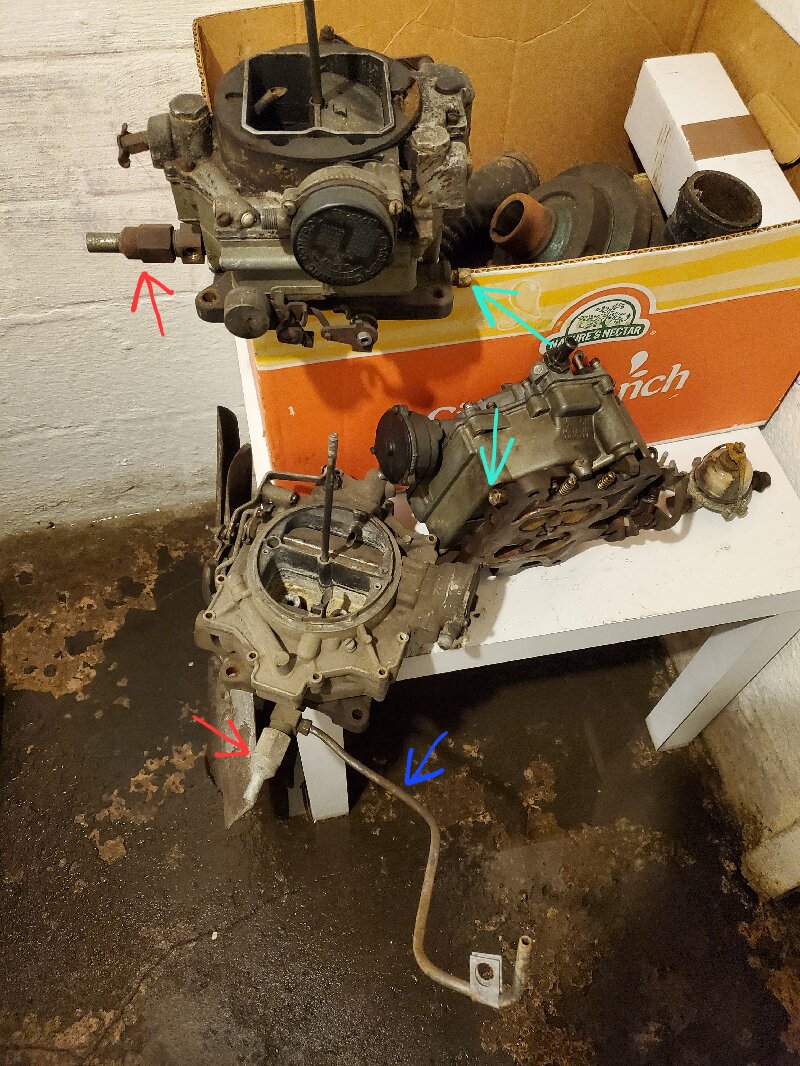
 Screenshot_20240530-203717_Gallery.jpg (856.16 KB)
Screenshot_20240530-203717_Gallery.jpg (856.16 KB)
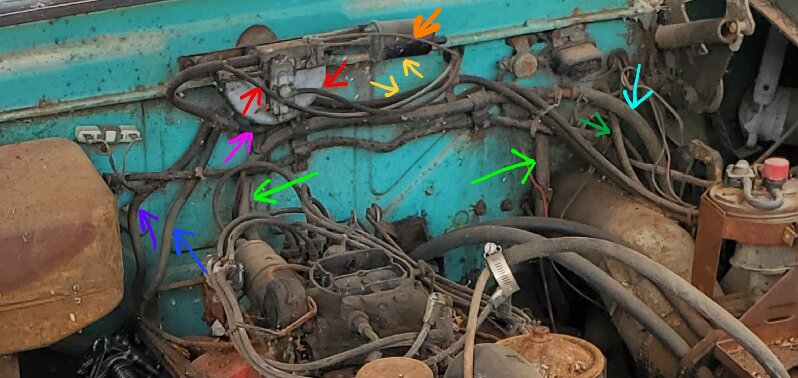
 Screenshot_20240530_205925.jpg (348.86 KB)
Screenshot_20240530_205925.jpg (348.86 KB)
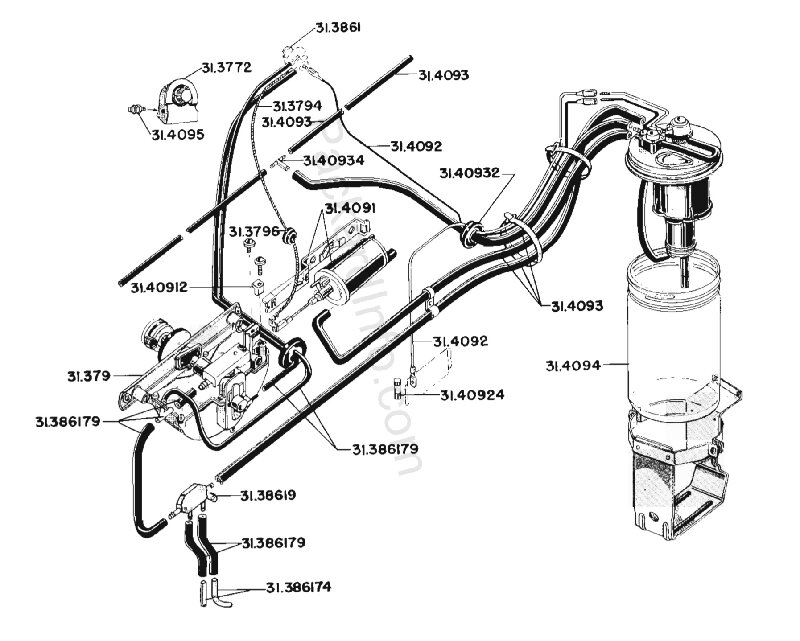
 20240530_205638.jpg (1,193.71 KB)
20240530_205638.jpg (1,193.71 KB)
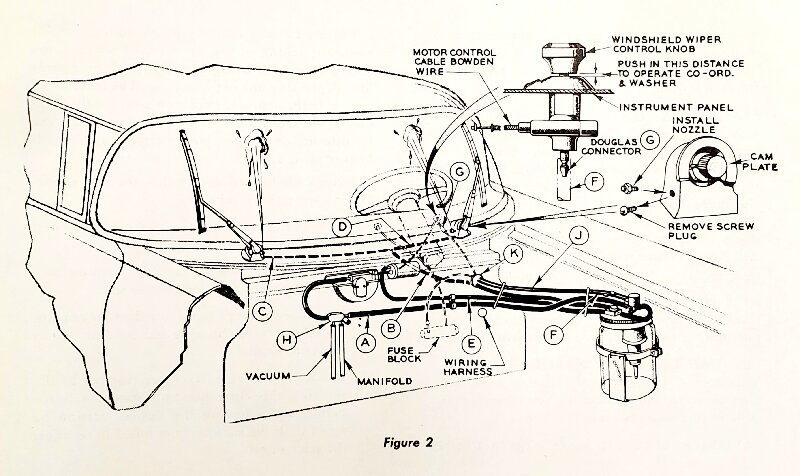
 20240530_205155.jpg (677.58 KB)
20240530_205155.jpg (677.58 KB)
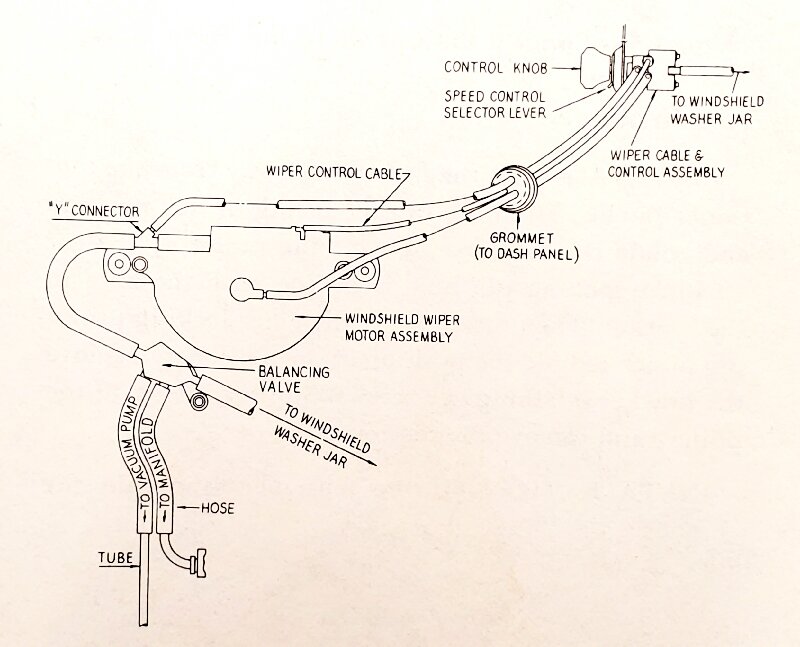
Vacuum comes from two sources: the engine vacuum pump in the crankcase, and the engine manifold. It is used for 3 things:
- distributor advance
- windshield wipers/washer
- power brakes (if equipped)
These are connected in 3 different ways. Reference the carburetor picture below. The two lower carbs are R4GC as used on a 55 senior car. The top one is a Carter, for a junior car.
- the distributor advance has a dedicated port and vacuum line, indicated by the teal arrows. This is so it is not affected by vacuum demand from other devices which would cause drops in the vacuum reading.
- the windshield items are powered by a tube indicated by the blue arrow. You can see the port in the Carter carb also, though the tube is missing.
- the power brakes are connected through a check valve indicated by the red arrows. This is so vacuum is preserved in case of engine failure; there is a reserve canister also, which will be mentioned later. For cars without power brake, this valve is simply replaced with a plug.
Now direct your attention to the engine bay photo and the three diagrams. Packard gave these three drawings of the windshield item connections; between them, it's easy to see the physical connections. The power brake connections you will need to refer to the photo only.
The line to the power brake is shown with lime green arrows. Note the T connector inline which connects the reserve cylinder indicated by the cyan arrow.
The lines for wiper power both go to the balancing valve first. These being the line from the carb (manifold vacuum), shown in deep blue, and the line from the engine vacuum pump, shown in purple. The balancing valve is simply a double check valve that allows only the line with a stronger vacuum to power the wipers. In addition to these two ports, the valve functions as a T connector for its devices. The left side runs to the wiper motor power port and the right side, shown in pink, runs to the washer power port.
The wiper is speed-controlled by a Bowden cable, orange, that moves a sliding pneumatic valve to adjust the vacuum connection to the motor proper. The range of travel of the motor is separately controlled by a cam with two profiles. The default position is the shorter range of motion. When a vacuum connection is completed through the red lines, a piston moves this cam to a different position, allowing the wiper to do the full stroke. The connection is accomplished through a sliding pneumatic valve on the wiper control.
When the wiper button is pushed in, a stud on the back of the unit is grounded. This is connected to the ground lead of the washer, with its other lead connected to the fuse panel. This electrical circuit activates the washer. The vacuum power connection is indicated in pink. The dark green is the washer fluid connection to the base of each wiper arm mount. Lastly, the yellow arrows are the coordinator and its vacuum line (which fell off). The coordinator is connected to the wiper motor and is just a vacuum piston. When activated, it pulls the wiper motor valve to the open position, activating the wipers to accompany the spray.
Hose sizes (all ID):
Power brake, all: 3/8"
Balancing valve except washer: 1/4"
All washer vacuum: 3/16"
Washer hose from washer: 1/4"
Washer hose to wipers: 1/8"
Range select hose: 1/8"
Hope this helps!

Attach file:
 20240530_211041.jpg (4,123.26 KB)
20240530_211041.jpg (4,123.26 KB)
 Screenshot_20240530-203717_Gallery.jpg (856.16 KB)
Screenshot_20240530-203717_Gallery.jpg (856.16 KB)
 Screenshot_20240530_205925.jpg (348.86 KB)
Screenshot_20240530_205925.jpg (348.86 KB)
 20240530_205638.jpg (1,193.71 KB)
20240530_205638.jpg (1,193.71 KB)
 20240530_205155.jpg (677.58 KB)
20240530_205155.jpg (677.58 KB)
This Post was from: https://packardinfo.com/xoops/html/modules/newbb/viewtopic.php?post_id=272250